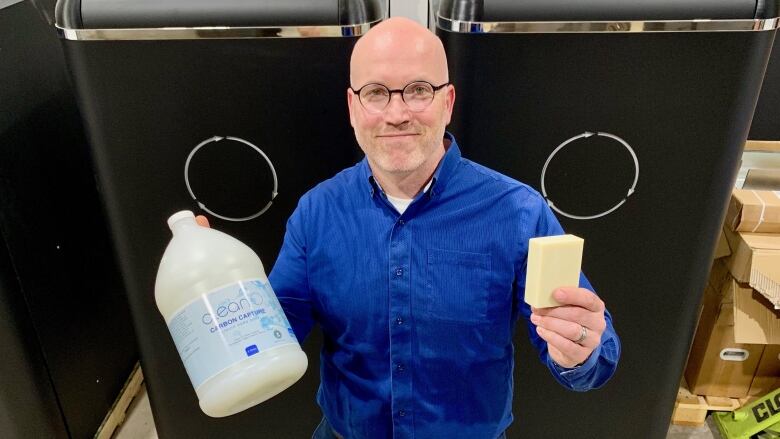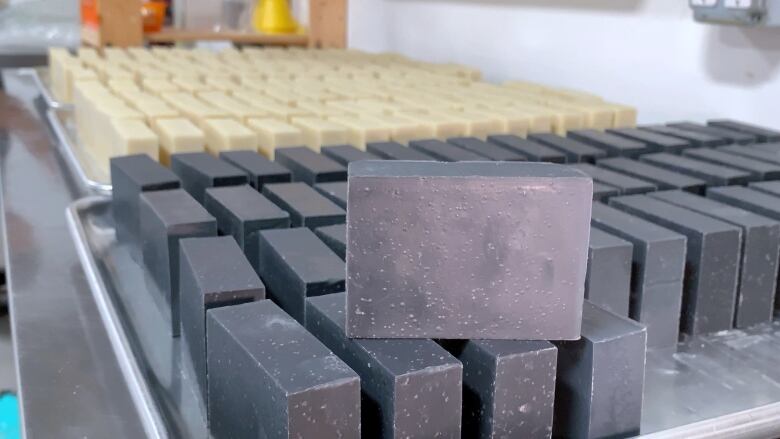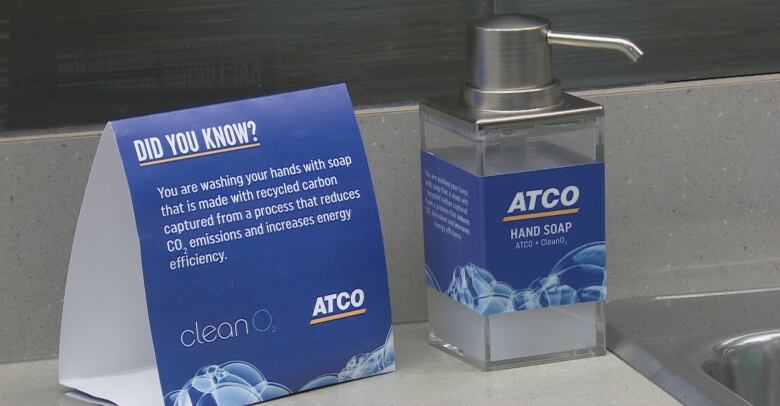Meet the startup turning CO2 emissions into handcrafted soap
New system aims to reduce energy costs and capture greenhouse gas emissions

For the last four months, Jill Hawker has experimented with mixing potash into her line of handmade soaps.
She's testing out how much of the material she can mix into her existing soap-making recipe and how the finished product stands up.
"So far, so good," said Hawker, the owner of All Things Jill. "We haven't had any issues with it at all. It's a really functioning bar of soap."

Hawker hadn't envisioned using potash in her products, but she's excited about how she's playing a part in capturing carbon dioxide emissions.
All of the potash comes from CleanO2, a Calgary startup that is gaining the attention of prominent business leaders and has substantial growth plans in Canada and abroad.
CleanO2 has developed the technology to turn CO2 emissions from industrial furnaces and boilers into potash for use in soaps, detergents, the agricultural sector, and the pharmaceutical industry, among others, using a device called CARBiNX.
There are a number of different types of potash a kind of potassium-rich salt including the material produced from mines in Saskatchewan, and the byproduct ofthis new carbon capture process.
Founder Jaeson Cardiff was working as a plumber in 2005 when came up with the idea. Since then, he's worked to refine the chemistry and grow the business to sell hisCARBiNX units, which are about the size of two refrigerators

Other companies are developing techniques to use carbon in plastics, adhesives, cementand concrete, among many others.
Of course, the products are not a cure-all for climate change, but they'll help decrease the amount of CO2 emissions released into the air.
"If you want to use natural gas for heat or for your building, you need a device to reduce the emissions associated with that energy source. This is a very easy means of achieving that," said Cardiff.

Canadian Natural Resources is the largest oil and gas producer in Canada and the biggest player in carbon capture and storage, where emissions are traditionally collected and pumped underground.
However, the company's executive vice-chairman is more excited about putting that carbon to use.
"CO2 is carbon and oxygen. These are not scary molecules. They aren't radioactive or anything like that," said Steve Laut, in an interview.
No wonder he likes to reference CleanO2 when he discusses greenhouse gas emissions in speeches and interviews.
"There are all kinds of innovative ways out there that use chemistry to actually make [CO2] into a product, which would be great because then you're actually reducing emissions and getting products out of it as well."

So far, CleanO2 has installed 14 of its CARBiNX units in Alberta and B.C. in a variety of facilities including a school, housing complex, industrial facilityand a power plant.
"We expect to sequester five to six tonnesannually of carbon dioxide," said Gregory Caldwell, with ATCO, a natural gas utility which has one of the CARBiNX units at its building in northeast Calgary.
As the world increasingly focuses on reducing greenhouse gases, there is pressure to cut fossil fuel use. However, many natural gas companies are looking for innovations thatreduce their emissions, to ensure the gas is used for decades to come.
"We see a future for natural gas being a part of low-carbon buildings and a low-carbon future. If we use technology like this, in addition to that fuel, we can really continue to reduce emissions but also keep costs reasonable for consumers," said Caldwell.
The units work by capturing CO2 emissions and absorbing them with a chemical, which is a type of hydroxide. The units produce potash, which is sold and the profit is shared between CleanO2 and the owner of the unit. CleanO2 estimates the CARBiNX units should pay for themselves in four or five years.
The units also reduce a facilities energy costs since they produce heat from the warmth of the emissions and the chemical reaction. The heat can pre-warm water before it enters a boiler, for instance.
"Regardless of your position on carbon emissions, I think everybody can agree on saving money and making some cash," said Cardiff.

In the last week, CleanO2 signed an agreement with Tundra Processing Systems to market and service its CARBiNX systems. Tundra sells and services industrial equipment across Western Canada.
The deal is why Cardiff is anticipating significant expansion. He expects upwards of 40 units to be operating by the end of this year and more than one thousand by the end of 2020. He's already envisioning global expansion, too.
"Think about the number of buildings that have heating appliances in them. It's pretty massive," said Cardiff. "We've had conversations with folks from Japan, as well as from Ireland. I have a meeting tomorrow with folks from Spain. It's gaining momentum rather quickly."
All of that growth will likely translate into a massive amount of potash. Edmonton-based cleaning products company Ostrem Chemical Co. already uses the potash from CleanO2 in some of its products, while the the Lush Cosmetics chain has a installed a CARBiNX unit and is testing out the material in its products.

In Calgary, Hawker is still fine-tuning her carbon-infused soaps before putting them on store shelves.
"I love what CleanO2 is doing as far as the carbon capture technology. I think supporting that might be of interest to customers," she said.
As CleanO2 expands, she's excited to see where this new product stream will go.
"They certainly produce a lot of potash, so there's lots of soap to be made."












_(720p).jpg)


 OFFICIAL HD MUSIC VIDEO.jpg)
.jpg)



























































































